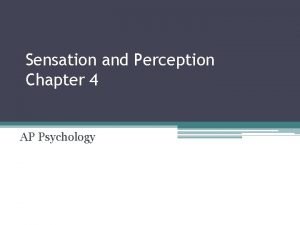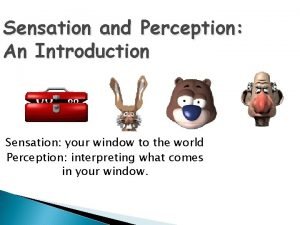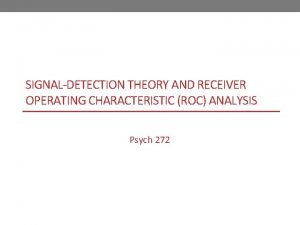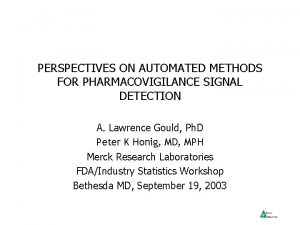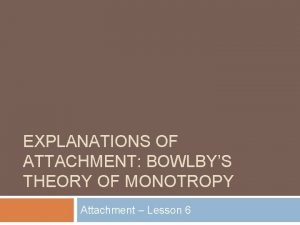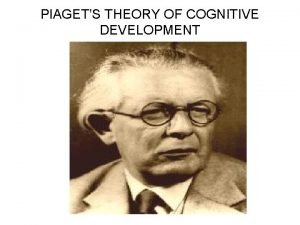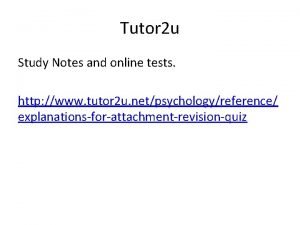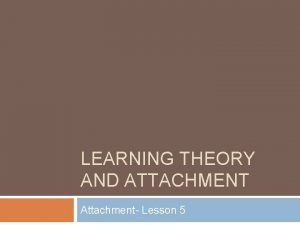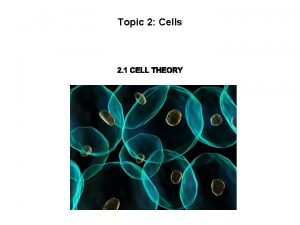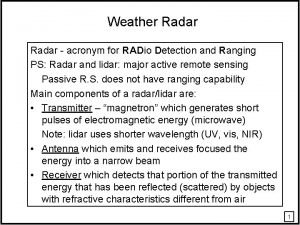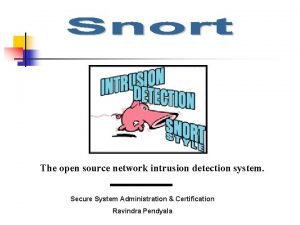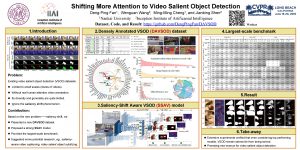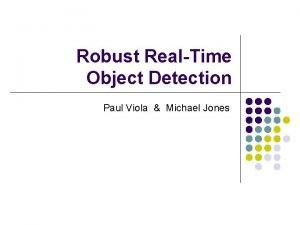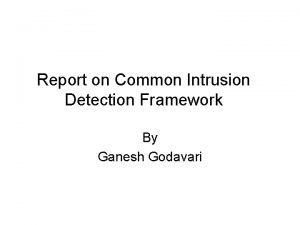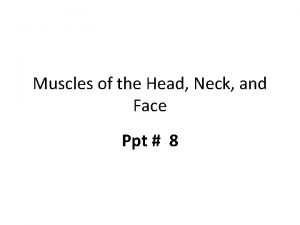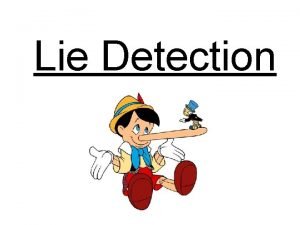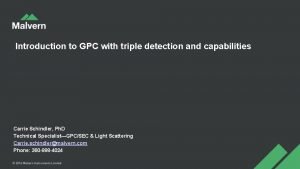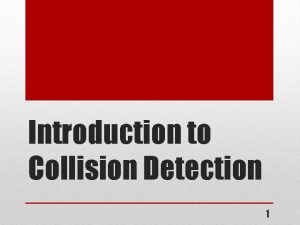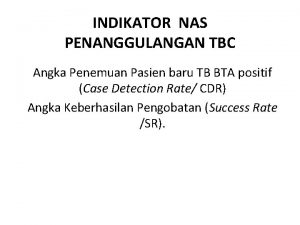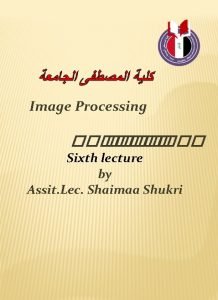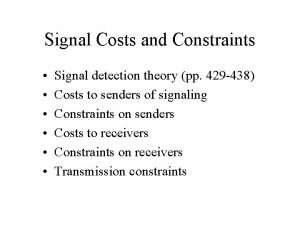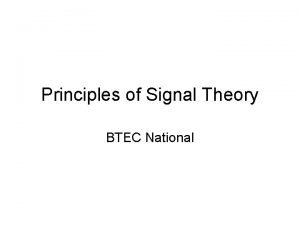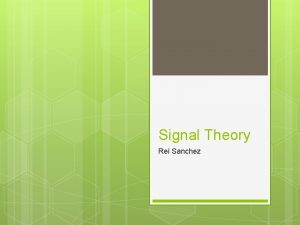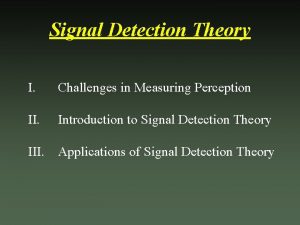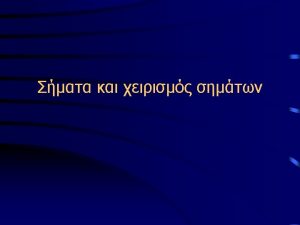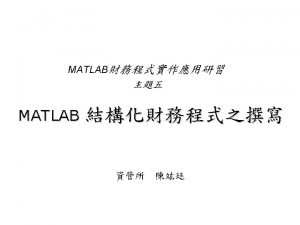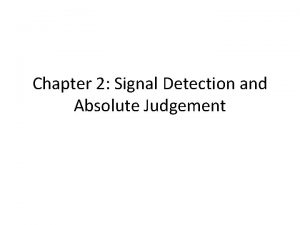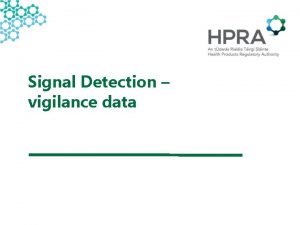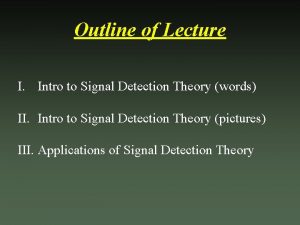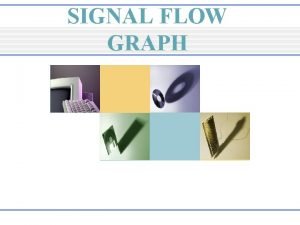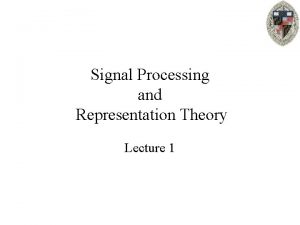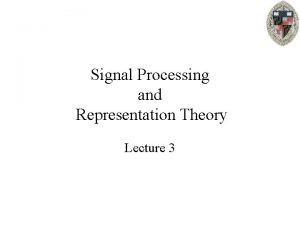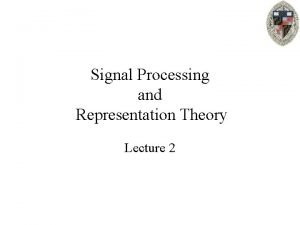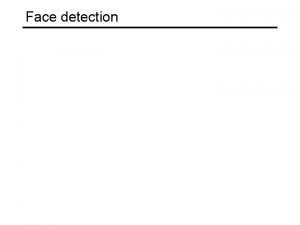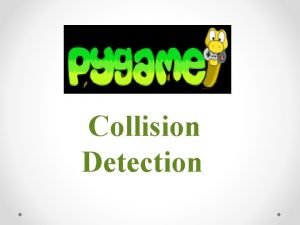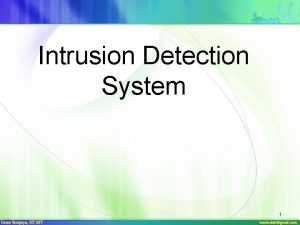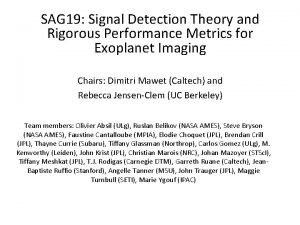Signal Detection Theory Outline of Lecture I Challenges












































- Slides: 44

Signal Detection Theory

Outline of Lecture I. Challenges in Measuring Perception II. Introduction to Signal Detection Theory III. Applications of Signal Detection Theory

Part 1 Challenges in Measuring Perception

Psychophysics is the science of establishing quantitative relations between physical stimulation and perceptual events.

The Method of Limits Experimenter adjusts intensity until the stimulus is detected.

The Method of Limits Advantage: Measurements are made quickly. Disadvantage: It is not clear exactly what’s being measured (no control for bias).

“Catch Trials” The subject is asked to make a response when no stimulus has been presented (also called “noise only” trials).

Not All Errors Are Equal 1. Reporting stimulus is present when it’s absent (“false alarm”). Versus 2. Reporting stimulus is absent when it’s present (“miss”).

Correct Responses Differ, Too 1. Reporting stimulus is present when it’s present (“hit”). Versus 2. Reporting stimulus is absent when it’s absent (“correct rejection”).

Absent Present Stimulus-Response Matrix Correct Rejection False Alarm Miss Hit “No” “Yes” Response

Part II Introduction to Signal Detection Theory

Part II Introduction to Signal Detection Theory S. D. T. In Words

Signal Detection Theory S. D. T. is a procedure for measuring sensitivity to stimulation, independent of the subject’s response bias.

Signal Detection Theory S. D. T. reduces the stimulus-response matrix to two meaningful quantities. 1. Detectability (d’) - a subject’s sensitivity to stimulation. 2. Criterion (b) - a subject’s inclination to favor a particular response; bias.

Part II Introduction to Signal Detection Theory S. D. T. In Pictures

Distributions of Sensory Responses

Distributions of Sensory Responses Spontaneous Activity is Constant

Distributions of Sensory Responses Spontaneous Activity is Normally Distributed The “Noise” Distribution

Distributions of Sensory Responses A Mild Stimulus is Presented (d’=1) The “Noise” Distribution The “Signal + Noise” Distribution

Distributions of Sensory Responses A Moderate Stimulus is Presented (d’=2) The “Noise” Distribution The “Signal + Noise” Distribution

Distributions of Sensory Responses An Intense Stimulus is Presented (d’=3) The “Noise” Distribution The “Signal + Noise” Distribution

Distributions of Sensory Responses Sub-Threshold Stimulus is Presented (d’=0) The “Noise” Distribution The “Signal + Noise” Distribution

Criterion The “Noise” Distribution The “Signal + Noise” Distribution

Neutral Criterion The “Noise” Distribution The “Signal + Noise” Distribution . 5. 5

Liberal (low) Criterion The “Noise” Distribution The “Signal + Noise” Distribution . 2. 6

Conservative (high) Criterion The “Noise” Distribution The “Signal + Noise” Distribution . 6. 2

Receiver Operating Space

Receiver Operating Characteristics 0 = d’

R. O. C. Curves 1 = d’ 0 = d’

R. O. C. Curves 1 = d’ 0 = d’

R. O. C. Curves 2 = d’ 1 = d’ 0 = d’

R. O. C. Curves 3 = d’ 2 = d’ 1 = d’ 0 = d’

R. O. C. Curves

R. O. C. Curves = d’ -1 = d’ -2 = ’ d -3

Part II Introduction to Signal Detection Theory S. D. T. In Numbers

Normal Distributions S. D. T. is based on normal distributions. Each normal distribution is described by a mean and a standard deviation.

Normal Distributions A given point on a normal distribution can be described 3 ways. 1. Percentile (also proportion) 2. Z-score (# of standard deviations) 3. Probability Density (likelihood)

Computing Detectability d’ = z. Hits - z. False Alarms In excel, the “norminv” function is used: Input = proportion Output = z-Score Conceptually, detectability (d’) increases with the area under the R. O. C. curve.

Computing Criterion b = Hit Density / False Alarm Density In excel, the “normdist” function is used: Input = z-Score Output = density Conceptually, b is equal to the slope of the R. O. C. curve at single point.

Part III Applications of Signal Detection Theory

S. D. T. Applications S. D. T. can be used in perceptual discrimination experiments.

S. D. T. And Discrimination The “slow” distribution The “fast” distribution

S. D. T. Applications S. D. T. can be used in non-perceptual research, including memory experiments.

S. D. T. And Memory The “new items” distribution The “old items” distribution
 Signal detection theory example
Signal detection theory example What is subliminal music
What is subliminal music Signal detection theory example
Signal detection theory example Signal detection theory example
Signal detection theory example Signal detection theory roc curve
Signal detection theory roc curve Pharmacovigilance signal detection methods
Pharmacovigilance signal detection methods 01:640:244 lecture notes - lecture 15: plat, idah, farad
01:640:244 lecture notes - lecture 15: plat, idah, farad Baseband signal and bandpass signal
Baseband signal and bandpass signal Baseband signal and bandpass signal
Baseband signal and bandpass signal Digital signal as a composite analog signal
Digital signal as a composite analog signal The product of two odd signals is:
The product of two odd signals is: Lecture outline example
Lecture outline example Lecture outline example
Lecture outline example Lecture outline example
Lecture outline example Lecture outline meaning
Lecture outline meaning Bread sentence
Bread sentence Natural language processing
Natural language processing Bayesian decision theory lecture notes
Bayesian decision theory lecture notes Sargur srihari
Sargur srihari Natural language processing lecture notes
Natural language processing lecture notes Monotropy definition
Monotropy definition Conclusion of piaget's theory
Conclusion of piaget's theory Outline bowlby's theory of attachment 6 marks
Outline bowlby's theory of attachment 6 marks Outline and evaluate the learning theory of attachment
Outline and evaluate the learning theory of attachment Outline the cell theory
Outline the cell theory Radar stands for radio detection and
Radar stands for radio detection and Detection bias example
Detection bias example Intrusion detection open source
Intrusion detection open source Mips alu design
Mips alu design Audit risk model formula
Audit risk model formula Java deadlock detection
Java deadlock detection Shifting more attention to video salient object detection
Shifting more attention to video salient object detection Speed detection of moving vehicle using speed cameras
Speed detection of moving vehicle using speed cameras Robust real-time object detection
Robust real-time object detection Common intrusion detection framework
Common intrusion detection framework Silver tickets adsecurity spn
Silver tickets adsecurity spn Recent developments in object detection
Recent developments in object detection Hash detector
Hash detector Face detection ppt
Face detection ppt Extrusion detection
Extrusion detection History of lie detection
History of lie detection Gpc
Gpc Collision detection discrete vs continuous
Collision detection discrete vs continuous Rumus case detection rate
Rumus case detection rate Edge detection sobel
Edge detection sobel

